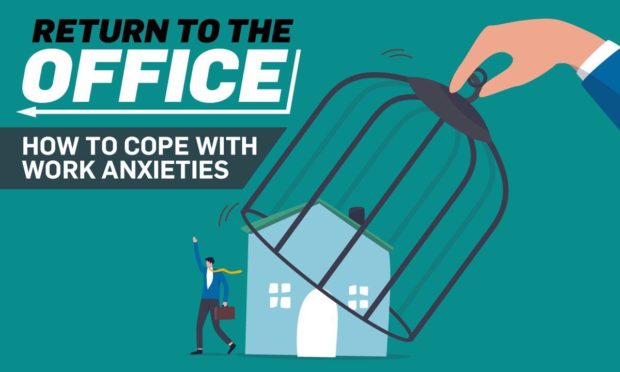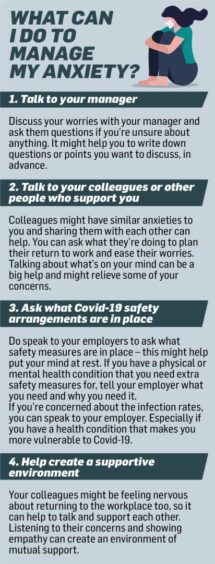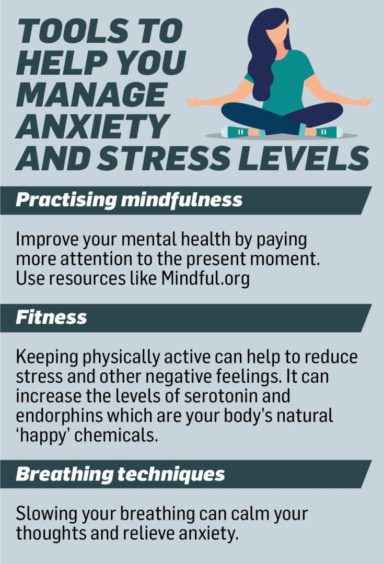Nervous about going back to the office? You’re not alone.
After nearly two years out of the hustle and bustle of the nine-to-five, it may come as no surprise that many are feeling anxious about returning to their normal place of work.
While working from home has brought challenges of its own, both to our mental health and to productivity levels—the prospect of getting out of bed and slipping into our forgotten office attire presents a new one.
According to the Scottish Government, beyond Level 0 a “gradual return to offices can now begin”, but home working will continue to be an important mitigation for controlling the virus.
Some might be ‘desperate’ to get back to the office
Occupational psychologist Eleanor Rutherford, who is also a lecturer in psychology at UHI, said people will feel very differently about returning to work, with some more eager than others to get back to their desks.
However, it is just as important to acknowledge those who are desperate to do so.
“There’s kind of a huge, huge range there,” she said.
“It’s kind of easy to say people are feeling anxious about going back to the office, but that’s going to encompass a lot of different people who have a lot of different reasons for the anxiety.”
Workers may want to change their jobs
Eleanor cited health and safety aspects as a cause for genuine concern, where staff might not feel like the employer is taking enough precautions.
And for others, who have had 18 months to revaluate their life and career prospects, they might feel returning to the office will “represent a reality” where the job is no longer suitable for them.
“For a lot of people, they might actually decide their current job isn’t what they want to do for the rest of their life,” she added.
“I think it’s difficult with anxiety, because for most people the essential thing is to take the opportunity to be clear in their own heads about what they’re feeling anxious about.”
‘Acknowledge you’re feeling anxious’
The British Psychology Society has listed fears of redundancy, being re-furloughed, moral distress, changes to work role and practices and impact on job performance as some of the psychological work-related distress people might experience.
To combat this, Eleanor has recommended giving yourself the time and space to “appreciate your own feelings”.

“Given that it’s been such an extreme situation that we’ve all gone through in the past 18 months— anxiety is a fairly natural reaction to that.
“Sometimes people think ‘I shouldn’t be anxious’ when you get into this worrying cycle, feeling that you’re beating yourself up about being anxious or trying to force yourself not to be anxious.
“So, I think the first step is generally just to take the time to acknowledge your own anxiety.
“This can help to depersonalise it as well, by thinking ‘I’m experiencing anxiety at the moment’ or ‘My brain is telling me I’m anxious at the moment’.
Try writing about your concerns
“If you’re not sure about why, maybe writing things down is a really good technique.
“Writing things for yourself, you don’t need to show this to anyone, and thinking: ‘Okay, I’m anxious about going back to work, what are my top five concerns about being anxious about going back to work?”
Once writing out your thoughts, Eleanor said they are easier to deal with because practical issues can have practical solutions.
Some might find that these worries might be issues that need to be managed psychologically.
Whereas with more practical issues, the help and advice might be sought through speaking to a manager or the HR department.
Eleanor added: “If it’s purely that you’re worried about knowing someone that’s shielding, or knowing someone vulnerable and concerned about being in an office, I think the advice there might be more practical.”
Keeping your line manager aware and speaking to HR where appropriate is key.
Feeling socially anxious? We have spent most of our lives being social animals
Socialising and sitting near colleagues for longer periods can be daunting to some who have relied purely on video conference calls and virtual get-togethers.
After minding how much space exists between you and others, it can be difficult to readjust to how we communicate with others in person.
However, Eleanor has given us a positive reminder by advising us we have “spent most of our life being social animals” and our social skills are still there—even if they are rusty.

She said: “You have those social skills, so it’s about remembering that this is something that you’ve done for a long time, that you’re able to do, and that it’s not a new skill you’re learning.
“It’s an old skill that you’re just going to be practising.
“Another positive point to remind people of is you spent 18 months on Zoom meetings, team meetings or phone calls or whatever— it’s much easier to communicate face-to-face than with a dodgy internet connection.”
It will be difficult for new members of staff too
As for new starts who may have never met the current staff in person or been in the physical office, and are experiencing jitters on their first day back, Eleanor said remembering the contact that has already been made with existing team members.
Existing staff should be mindful they may need to know things they already take for granted like where the toilets are and how to get around to certain parts of the office.
“It’s going to be obviously very strange for new starts as well.
“And for us all to remember to make the effort to include people if you’re sitting in the lunchroom and someone is new—that can be an easy way to get speaking.
“If you’re a new start, be polite and ask questions. People like talking about themselves generally, so asking those polite questions can help to start to get to know people.”
Practical action plan helps resolve worries
If you have always been an anxious person, relying on psychological techniques to manage it will be just as important as before returning to work.
Eleanor advised using breathing techniques or distracting yourself by looking at something for five minutes to bring yourself back to a place you can cope.
She added: “Taking that time to find out what is making you feel anxious, then addressing it and say: ‘Okay, so what’s the best way that I can deal with this problem’.
“Externalising things by putting it down on paper can be really helpful to make the problem manageable— to turn it into a problem that you can start to kind of cognitively solve rather than potentially emotionally react to.
“But it’s very much about what’s the problem you’re dealing with, because the solution will vary depending on what the problem is.”
She added: “It can be easy to feel trapped, but putting things down on paper and having a practical action plan and saying ‘Okay, this might not be the ideal situation. It’s not going to last forever, and I know what steps I can take in order to resolve the situation’.”



